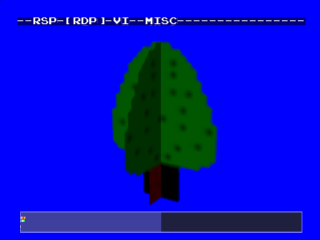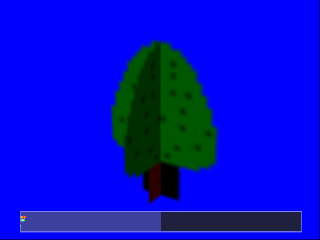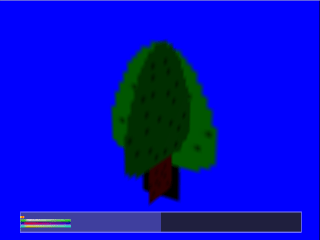| 0xXX | Function | Lower Word | Action | Description | RESULT |
| 0x02 | SetAlphaCompare() | 0x00000000 | None | Do not compare, Normal Non-Transparent Textures (or Multi-Bit Alpha) |  |
| 0x00000001 | Threshold | Compare with the blend Colour Alpha value, Used for 1 bit alpha transparent textures if Fog Enabled |  |
| 0x00000003 | Dither | Compare with a random dither value, Makes for odd Partical effect (eg flies) |  |
| 0x01 | SetDepthSource() | 0x00000000 | Pixel | Use the Z value and deltaZ value repeated for each pixel | |
| 0x00000004 | Primitive | Use the primitive depth register's Z value and deltaZ value.
This is faster but less accurate
/n64man/gdp/gDPSetDepthSource.htm | |
| 0x1D | SetRenderMode(|) | 0xFFFFFFFF | | Options Below | |
| 0x10 | Blender | ? | ? | ! Discontinued and reserved in F3DEX ! | |
Setting the DepthSource to a Primitive Can be used for 'Horizon' Images.
In this case you model a horizon close to the player (a dome or cylinder centered around the players head, but orientated to the world), Then you set its z-value to 0x7fff (Far Clip Plane). This will cause the Horizon Image to always be at the back. FOG however will apply (since FOG is calculated on Z Value) so FOG needs to be disabled for the Horizon Display List.
Example:
| // Set cycle type | |
| gDPSetCycleType(G_CYC_2CYCLE); | BA001400 00100000 |
| // Set rendering mode | |
| gDPSetRenderMode(G_RM_AA_ZB_TEX_EDGE, G_RM_AA_ZB_TEX_EDGE2); | B900031D 00552078 |
| // Set depth source value | |
| gDPSetDepthSource(G_ZS_PRIM); | B9000201 00000004 |
| // Set primitive depth | |
| gDPSetPrimDepth(2047, 0); | EE000000 7FFF0000 |
Interesting Note - Decals:
The dz (Delta-Z (Change-In-Z)) value should be set to 0. This value is used for antialiasing and objects drawn in decal render mode and must always be a power of 2 (0, 1, 2, 4, 8, ... 0x4000). If you are using decal mode and part of the decaled object is not being rendered correctly, try setting this to powers of 2. Otherwise use 0.
|
-Bit Map-----------------------------------------------------------------
| [------------------MUX 1 and 2 see Below!----------------] |
| 0 0 0 0 1 1 0 0 0 0 0 1 1 0 0 0 |N/A
| see MUX BitMap Below |
| |
| 15 14 13 12 11 10 09 08 07 06 05 04 03 02 01 00 |Bit Number
| 0 0 1 0 0 0 0 0 0 1 1 1 1 0 0 0 |Runway 66AFD4
| te fb acs cxa ze zi cf cw cc ir du dc AA Pr Di Th |Flags
| [-------------------flags-------------------------][-flags-] |
| Flags Confirmed |
-------------------------------------------------------------------------
#define GBL_c0(m1a, m1b, m2a, m2b)
(m1a) << 30 | (m1b) << 26 | (m2a) << 22 | (m2b) << 18
#define GBL_c1(m1a, m1b, m2a, m2b)
(m1a) << 28 | (m1b) << 24 | (m2a) << 20 | (m2b) << 16 |
OK, So MUX is now figured out. To Start with this didnt make sence, but after compiling my own code, it works.
The numbers are (16-30) BitShifts.
This works out like the following Bit map of the Upper Half Lower Word B90000 XXXX0000:




 RenderMode: RenderMode
AA_EN Z_CMP Z_UPD Z_XUL IM_RD AA_EN Z_CMP Z_UPD Z_XUL CVG*A C_CVG FC_BL IM_RD
Alpha Compare: THRESHOLD Alpha Compare:None
RenderMode: RenderMode
AA_EN Z_CMP Z_UPD Z_XUL IM_RD AA_EN Z_CMP Z_UPD Z_XUL CVG*A C_CVG FC_BL IM_RD
Alpha Compare: THRESHOLD Alpha Compare:None

 RenderMode: RenderMode
AA_EN Z_XUL FC_BL C_CVG IM_RD AA_EN Z_CMP Z_UPD Z_OPA A_CVG IM_RD
Alpha Compare:None Alpha Compare:None
For more Information on Transparent Primitives go here
Blender Multiplexor decompilation
=================================
Description of Blender Mux (c0/1):
Mux1 or c0 is the first pass in the blender. As stated above it normally takes Fog.
Mux2 or c1 sets the second pass. From experiments with CCBL it seems as though the best
settings are, Colour_In * Alpha_In + Colour_Mem * Alpha_Mem.
You will notice its an equation. CCBL shows this as follows (showing both MUX's)
RenderMode: RenderMode
AA_EN Z_XUL FC_BL C_CVG IM_RD AA_EN Z_CMP Z_UPD Z_OPA A_CVG IM_RD
Alpha Compare:None Alpha Compare:None
For more Information on Transparent Primitives go here
Blender Multiplexor decompilation
=================================
Description of Blender Mux (c0/1):
Mux1 or c0 is the first pass in the blender. As stated above it normally takes Fog.
Mux2 or c1 sets the second pass. From experiments with CCBL it seems as though the best
settings are, Colour_In * Alpha_In + Colour_Mem * Alpha_Mem.
You will notice its an equation. CCBL shows this as follows (showing both MUX's)